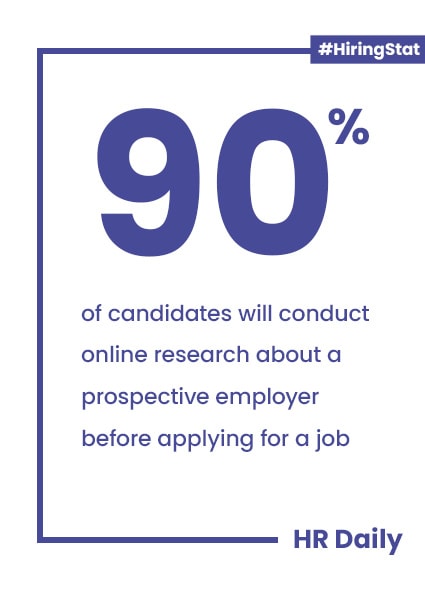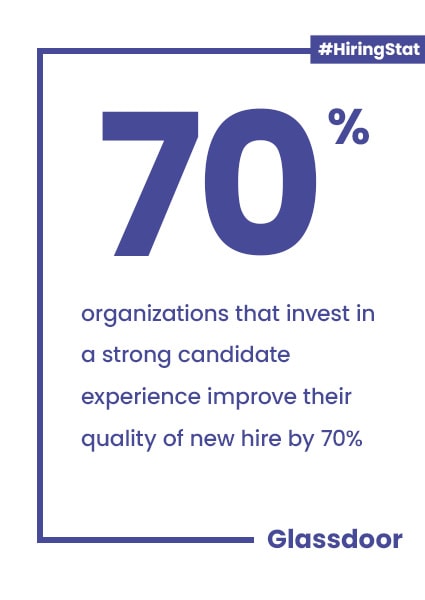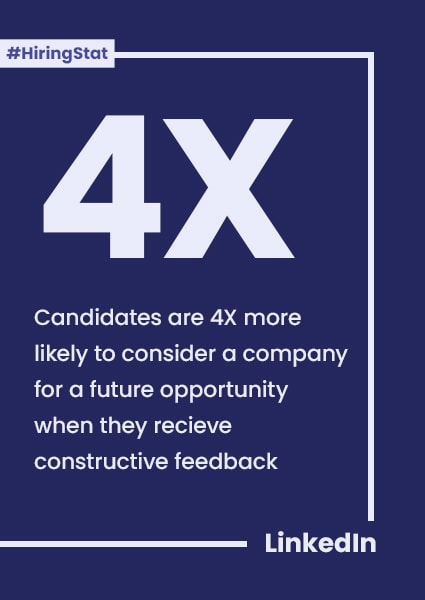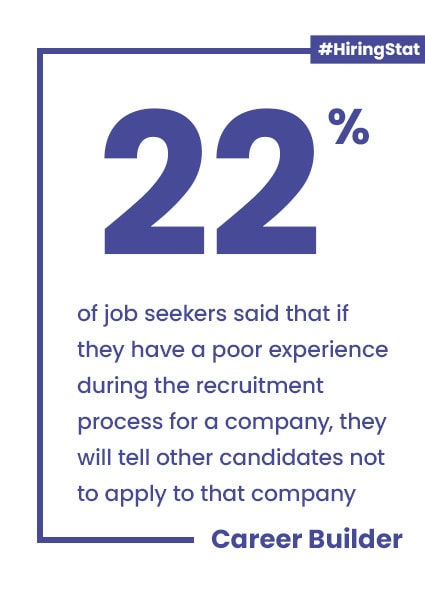With an estimated 6.3 million more jobs available in 2023 and a lack of workers to fill them, candidate engagement has never been more crucial for a successful talent attraction and recruitment strategy.
Talent engagement is also vital for employee retention and business growth. In the wake of the COVID-19 pandemic, employee expectations have changed. Retirement is up, quiet quitting is diminishing productivity, and the “great resignation” is not over.
As the competition for talent intensifies, a proactive Candidate Engagement System is essential to build talent pools and pipelines and deliver your employee value proposition the skilled workers needed to fill job openings.
Here are a few tips on how you can boost talent engagement.
This Article Covers:
What is candidate engagement, and what does it mean for talent
acquisition?
At its core, candidate engagement is communication. It’s every bit of communication a person receives whether they are actively interested in a job opening or identified as a prospective candidate for future openings. Either way, talent engagement often starts with long before a prospective employee fills out their first job application with your company. 
Timely communication is a must to deliver your message and give candidates a clear picture of the company environment and culture, an expectations for the job seeker’s journey.
Engaging with candidates involves continual communication, networking, and on-going effort to create and maintain a viable talent pool. A talent engagement system provides effective and timely communications that brings your messaging to potential candidates and introduces them to your brand as an employer.
Candidate engagement is the culmination of passive candidate sourcing. When searching for top talent, your engagement with that talent is the first step towards recruiting.
When you identify A-players that are ideal for certain positions, the fact may be that they are not looking to change jobs. Talent engagement gives you the opportunity to call attention to your company and attract these passive candidates to your career opportunities.
Active job seekers also require engagement. People that apply for job postings, prospective candidates at job fairs, on-campus or industry events, internal employees looking for career advancement, website visitors who are curious about employment opportunities, career changers, and others who may be a good fit for your openings, all require communication that facilitates talent engagement.
How can a candidate engagement system help employers engage with gifted and talented workers? As communication is the key to delivering your employee value proposition, a talent engagement system is used to balance technology and task automation in the very personal work of recruiting.
Talent engagement happens throughout the candidate’s journey at every step of the recruitment process. This includes everything from creating awareness of your employer value proposition to job application and candidate assessment, to the interview process and offer stages, to onboarding and beyond.
An ideal candidate engagement system integrates with your applicant tracking system and onboarding software to deliver a seamless candidate experience.
Having Trouble Creating Meaningful Engagement?
![]()
SmartSearch is an easy-to-use platform for recruiting and hiring professionals that need to combine multiple systems into one platform for better recruiting process.
Strategies for engaging with the best candidates in your talent pool.
 An effective candidate engagement system involves communication across multiple channels to break through the clutter, set yourself apart from the competition, and reach desirable candidates.
An effective candidate engagement system involves communication across multiple channels to break through the clutter, set yourself apart from the competition, and reach desirable candidates.
This is typically a combination of email, text messaging, social media outreach, chatbots and conversational AI, phone or face-to-face video calls, and in-person meetings. It can also include the company newsletter, video content, and public service messages. The right mix of communication tools is needed to appeal to different generations, diverse populations, and professionals with the desired experience and skill sets.
In addition, your candidate engagement system must be able to tailor and personalize the message to specific personas. Constant, friendly, and compelling communication is what it takes to keep top talent engaged at each step of the recruiting process, or candidates may lose interest – or be lost to the competition.
Communication is about setting expectations. Be sure your candidate engagement system communicates details of your company’s hiring practices, approximate timing, how and when their application is moved to the next stage, and when they can expect to hear back from you. Most importantly, keep your promises and stick to your timeline. A talent engagement system is used to let candidates know they are valued and that you appreciate their time.
Steps for Building Better Engagement
The goal a candidate engagement system is to deliver your employment message. Engaging with your talent pool in a way that communicates your company mission, vision, and values so that prospective candidates see themselves working happily and successfully in the role you want to fill.

There are two types of metrics that recruiters can use to track and improve their candidate engagement. The first is conversion metrics, and the second is success metrics.
Your conversion metrics include any data gathered throughout a candidate’s journey from prospect to potential hire. For the most part, these data points are gathered through tracking tools and applications that automatically source the data once a potential candidate shows interest in an open position.
While thousands of data points can be tracked and reported on, many employers find it best to track the following conversion metrics when scoring their candidate engagement:
1. Application Completion Ratio:
The ratio of completed applications vs. those that were started indicates whether the job posting and process for completing the application kept potential candidates engaged.
When evaluating this ratio, it is important to review the information presented in the job description and the reasonable time it takes an internal team member to complete the application.
2. Source of Hire:
Understanding the sources through which candidates discover opportunities to work with your company is crucial for optimizing your candidate engagement.
Employers can determine which channels are most effective when building their engagement strategy by tracking these different sources, such as career websites, job boards, social channels, referrals, or direct sourcing.
This applies not only to sourcing new candidates but in structuring the delivery of key communications throughout the hiring process.
3. Content Engagement:
What happened after a candidate showed interest in an open position? Did they visit your website? Did they read one of your company’s press releases? Did they go searching for reviews of your company on different ranking sites?
By understanding these different responses and how it affects candidate engagement, any company can take steps to guide top candidates to the resources that lead to a positive outcome.
4. Time to Hire:
Depending on the position, the time to hire may be longer or shorter. By taking the time to track and set an approved hiring time frame, recruiters and build in personal or automated touchpoints into the recruitment process to keep top candidates engaged.
Having a longer hiring process is okay, but candidates are less likely to stay positive during a long process if there is poor communication.
5. Stage-Specific Conversion Rates:
Stage-specific conversions refer to those that continue to the next phase of a company’s recruitment process. This can include those selected for additional background screenings, interviews with key team members, or the final stage of a job offer.
To properly track these conversion rates, it is important to track the number of candidates selected to move forward and include the why. Why was a candidate selected vs. not? Why was a specific candidate hired over another?
Collecting this information from different team members informs the recruitment team of qualifications for future hires and ensures compliance by all parties.
While your conversion metrics deal with hiring process information, success metrics are all about results. These metrics include:
1. Feedback Surveys:
Asking a candidate for feedback is not only a direct method for understanding where your candidate engagement strategy may fall short, but it can also help build trust with your employer brand.
2. Offer Acceptance Ratio:
Of the candidate or candidates selected for the position, how many of them accepted the offer? A clear indicator of issues that may exist in your candidate engagement process is why a job offer is declined.
3. Job Tenure:
According to a study by the Society for Human Resources Management (SHRM). A great candidate experience ensures that 69% of employees stay with a company for three years. A candidate’s tenure with any position helps indicate areas of improvement.
In addition to the right mix of communication tools, you’ll need database software to serve as a candidate engagement platform and infrastructure of your candidate engagement system to manage, automate, and track actions. An applicant tracking system usually provides a combination of tools that serve as the hub for talent engagement and workflow automation that creates a responsive and enjoyable candidate experience.
Even though you may reject the vast majority of applicants or have to process a high volume of candidates, there’s technology available to ensure that the recruiting experience is engaging for every candidate.
Applicant Tracking Systems:
A robust Applicant Tracking System (ATS) serves as the central database. Look for scalability to support growth and a high volume of activity, flexibility to adapt to changes in your workflow, and innovation that keeps pace with market trends and new technology. The best applicant tracking system is one that enables recruiters to review applicants quickly, communicate with candidates in a timely manner, engage throughout the process, including getting feedback from candidates. The ATS will organize individual records, sort talent pools, create a proactive talent pipeline, and provide corresponding workflow tools to manage communication across various segments of your networks.
Digital Career Center:
This is a key part of the overall candidate engagement system. Your online jobs pages must be inviting to new candidates researching open positions within your company. Make it quick and easy to apply. A well-designed application reduces candidate “fall off” by collecting only as much information as needed to start the talent engagement. A long application form discourages candidates; you can collect additional information as part of the candidate engagement and dialog. An engaging career center will feature a variety of communication capabilities built in such as chatbots, automated responses, and tools for the candidate to set-up their own job alerts, share a job on social channels.
Candidate Relationship Management:
Just like Customer Relationship Management (CRM) is vital for sales and recruiting marketing, it’s the same with recruiting and talent engagement. In fact, consumer and employer brands are intimately linked – and each can help strengthen each other’s message. A powerful candidate engagement system will have an arsenal of CRM tools such as two-way SMS texting, mass email and email campaigns, call list functionality, social media links for conversations and sharing information, along with ability to automate regular and routine communication. When used for talent engagement, the CRM is how you keep in touch with “silver medalist” candidates that didn’t get hired but may be a good fit for future opening, along with candidates that reject an offer or decide to stay with their current employer. Send a periodic email or automate social media outreach, especially when you have a new job opening that may be of re-engaging with skilled and previously qualified candidates already in your database
Vendor Management System:
When working with staffing agencies, you’ll need a Vendor Management System (VMS) that organizes communication between your preferred vendors and provides a portal for hiring managers to expedite review of candidate submissions. The principles of talent engagement are the same regardless of whether you’re hiring for a permanent or contingent position and using a staffing agency to fill a job. Once candidates are submitted by your vendor partners, you’ll want to nurture long-term relationships with good temporary workers who are already familiar with your company, and even with individual candidates who do not get hired. Much like the ATS, the VMS organizes temporary workers and other potential recruits by Source. Using a VMS that’s integrated with your Applicant Tracking System and Onboarding Software as part of the candidate engagement system has an additional advantage in that it can be used to engage your staffing vendors in the process of placing hard-to-find talent more quickly.
Employee Onboarding Software:
The hiring process does not stop once the offer letter is accepted. Talent engagement during onboarding is where retention starts. You need onboarding software with a mobile friendly portal to make it’s quick and easy for new hires to get the paperwork done, set expectations about next steps, and handle scheduling right up until the start-date. Multiple people in your organization become part of the talent engagement, and easy-to-use onboarding software is necessary to welcome your new hire in a way that makes them feel immediately valued and happier from day one.
HRIS Software:
Once new hires are successfully processed through the onboarding software and all candidate data gathered in the applicant tracking system is exported to the HRMS or HRIS, talent engagement does not stop there. As your employee population grows, internal candidates are also looking for career development opportunities – and one way to provide it is to make sure you’re continuing to communicate with them. Many ATS platforms features a digital career center section for “employees only” where you can promote job openings internally, as well as drive employee referrals.
Ready to build the recruiting tech stack of your dreams?
Effective candidate engagement starts with defining your employee value proposition and strategy. How will you communicate your company values to attract and engage the A-players in your industry?
Today’s tech-savvy, sophisticated job seekers are interested in finding meaningful work and jobs they love. That means something different to nurses than to software developers. In addition, with remote work in high-demand, and desire for contingent positions on the rise, how will you appeal to talent seeking more flexibility and better work-life balance?
jobs they love. That means something different to nurses than to software developers. In addition, with remote work in high-demand, and desire for contingent positions on the rise, how will you appeal to talent seeking more flexibility and better work-life balance?
Talent engagement and regular communication with your talent pool of past, present and future candidates is central to creating a positive experience. For passive candidate engagement, you can elevate awareness and generate interest using immersive content to create compelling stories about the company values that appeal to the specific talent you want to recruit.
You also need to consider generational differences and deliver your employment message in non-biased language to appeal to more diverse talent. It helps if prospective candidates can choose their preferred method of communication, some people use email as their source of information, others prefer a text message.
At SmartSearch, our goal is to provide an applicant tracking system and task automation that gives recruiters the time to have more meaningful conversations.
Our software gives recruiters the tools they need to take a human-centric approach to candidate engagement. You want people in relationships, automation on repetition. Where you have repetitious tasks, put your automation on. Where you need to form a relationship, that’s where you put your people.
Our applicant tracking system helps you set up workflows to boost candidate engagement at five stages:
1) Awareness. How will you call attention to your company and job openings?
2) Consideration. How will you get the candidate to consider making a job change?
3) Interest. Once a candidate is engaged, how will you keep them interested in a specific job opportunity as they advance in the recruiting process?
4) Evaluation. This includes the screening and interviewing stages of the recruitment lifecycle. How will you set expectations in a way that creates buy-in and generates excitement about joining your organization? Be mindful that at this stage the candidate is also evaluating YOU and your company. Just as important is how you treat the candidates that are eliminated from further consideration, how you handle rejection in a respectful and empathetic way is necessary to provide a positive experience to those who do not get the job.
5) Closing. This is all about commitment. Onboarding starts as soon as the offer is extended. How will you build-in timely communication that elicits action and follow-through by everyone involved in the process?
Here at SmartSearch, as an ATS solution that provides a full suite of tools to create a candidate engagement system, we find that flexibility and speed are imperative for communicating with top talent.